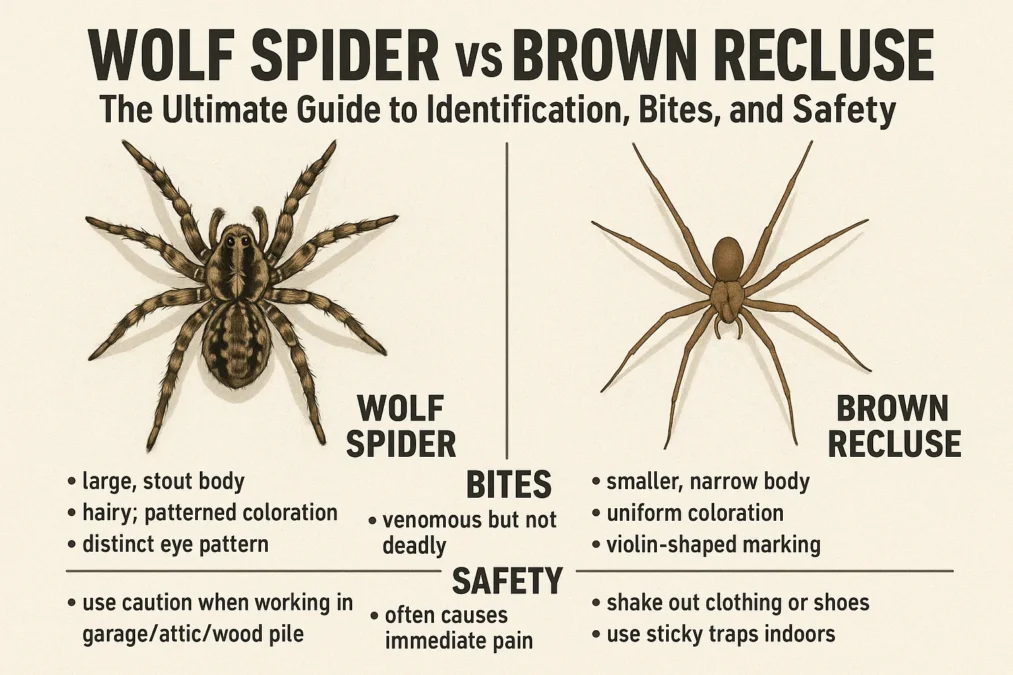Wolf Spider vs Brown Recluse: Walking into a dark corner of the garage or reaching into a dusty attic box only to find a spider can send a shiver down anyone’s spine. And if you live in certain parts of the country, that fear is often immediately followed by a frantic mental question: “Is that a dangerous brown recluse, or just a big, scary-looking wolf spider?” This confusion is incredibly common. Both are brownish, both are often found in and around homes, and both have garnered a reputation that far exceeds their actual behavior. But mistaking one for the other can lead to unnecessary panic or, conversely, a dangerous lack of concern.
Understanding the difference between a wolf spider and a brown recluse is a critical piece of knowledge for homeowners, hikers, and anyone who shares their space with these eight-legged inhabitants. This isn’t just about satisfying curiosity; it’s about safety, peace of mind, and responsible cohabitation with the natural world. This comprehensive guide will dive deep into every aspect of the wolf spider vs brown recluse debate. We’ll explore their physical characteristics in minute detail, decode their vastly different behaviors, demystify the realities of their bites, and provide you with practical, expert-backed advice on prevention and control. By the end of this article, you’ll be able to confidently tell these two arachnids apart and know exactly how to respond if you encounter one.
Understanding the Key Differences at a Glance
Before we delve into the intricate details of anatomy and ecology, it’s helpful to have a high-level overview of what sets these spiders apart. The fundamental distinction lies in their potential danger to humans. The brown recluse (Loxosceles reclusa) is one of the few spiders in North America whose venom is considered medically significant to humans. Its bite can, in a minority of cases, cause a severe reaction known as loxoscelism, which involves tissue damage and necrosis. The wolf spider (a term for many species in the Lycosidae family), on the other hand, is not considered dangerously venomous. Its bite may be painful and cause some localized swelling and itching, but it is not a medical emergency.
Another immediate difference is their appearance and hunting strategy. Wolf spiders are the rugged, athletic hunters of the spider world. They are often large, hairy, and fast-moving, relying on their keen eyesight to actively chase down prey. You’re just as likely to see one sprinting across your lawn at night as you are to find one in your basement. The brown recluse is a shy, reclusive predator—hence its name. It is smaller, less hairy, and prefers to hide in dark, undisturbed places, emerging to ambush prey that wanders into its small, irregular web. This behavioral difference is a key identifier: if a spider is boldly out in the open and moving with purpose, it’s far more likely to be a wolf spider than a brown recluse.
Detailed Physical Identification: Wolf Spider
Correctly identifying a spider is the first and most crucial step. Wolf spiders have a distinct appearance that, once learned, is difficult to mistake for a recluse. One of the most telling features of a wolf spider is its size and stature. These are robust, powerfully built spiders. Their bodies are covered in hair, giving them a somewhat furry or fuzzy appearance, which can make them look more intimidating than they actually are. Their coloration is typically a mix of brown, gray, and black in a pattern that often provides excellent camouflage against soil, leaf litter, and bark. These patterns are usually banding or mottling, not distinct, symmetrical markings.
The most reliable way to identify a wolf spider is through its eye arrangement. All spiders have eight eyes, but how they are arranged is unique to different families. Wolf spiders have a distinctive eye pattern: they have two large, prominent forward-facing eyes that give them excellent binocular vision for hunting, surrounded by a row of four smaller eyes below and two more medium-sized eyes set further back on the top of the cephalothorax (the front body segment). This configuration is a hallmark of the Lycosidae family. Furthermore, many female wolf spiders are famous for their maternal care. They carry their large, round egg sacs attached to their spinnerets at the rear of their abdomen, and after the spiderlings hatch, they will ride around on the mother’s back for a week or more until they are ready to disperse.
Detailed Physical Identification: Brown Recluse
The brown recluse is more subtle in its appearance, which is why close inspection is necessary for a positive ID. Unlike the hairy wolf spider, the brown recluse has a body that is mostly devoid of hair, giving it a smooth, almost velvety appearance. Its color is fairly uniform, typically a sandy brown to a dark tan, though its legs may be a slightly lighter shade. It is generally much smaller than the average wolf spider; a brown recluse’s body length (excluding legs) is usually about the size of a U.S. quarter, while a wolf spider’s body can often be larger.
The most famous—and most misunderstood—identifying feature of the brown recluse is the violin-shaped marking on its cephalothorax. This marking is why it’s sometimes called the “fiddleback” spider. It’s important to note this detail correctly: the violin is darker than the surrounding area, and the “neck” of the violin points backward toward the abdomen. However, this mark can sometimes be faint or inconsistent, especially in younger spiders, so it should not be used as the sole identifier. The most accurate way to confirm a brown recluse is, once again, by its eye pattern. Unlike most spiders which have eight eyes clustered into two groups, the brown recluse has six eyes arranged in three pairs. This unique configuration—a dyad, or pair of two eyes, with one pair on the centerline and the other two pairs flanking it laterally—is a definitive characteristic of the Loxosceles genus.
Habitat and Behavior: Where and How They Live
The lifestyles of the wolf spider and the brown recluse could not be more different, and understanding their behavior is key to knowing where to expect them. Wolf spiders are nomadic hunters. They do not spin webs to catch prey; instead, they are agile, ground-based pursuit predators. They use their incredible speed and keen eyesight to run down insects like crickets, cockroaches, and other small arthropods. They are most active at night and are often seen scurrying across open ground. During the day, they seek shelter under rocks, logs, leaf piles, or in burrows they dig themselves.
Wolf spiders are common in a wide variety of habitats, including grasslands, forests, wetlands, and, of course, in and around human dwellings. They often wander into homes by accident, usually through gaps under doors or through cracks in the foundation, while following prey. They are not inherently aggressive toward humans and will almost always choose to flee if given the opportunity. Their presence in a house can actually be beneficial, as they are effective natural pest control agents.
In stark contrast, the brown recluse is a master of hiding and ambush. Its name is perfectly chosen: it is both brown and profoundly reclusive. This spider spins a small, irregular, off-white web that is not used for trapping prey but rather as a retreat and a nursery for its eggs. It is a sedentary hunter, preferring to wait in its hidden refuge for a meal to wander by, which it then ambushes. Brown recluses have a strong preference for warm, dry, dark, and undisturbed spaces.
Common indoor habitats include cardboard boxes (which they especially love), closets, attics, basements, behind furniture, in storage areas, and in the voids under beds. They can also be found in garages, sheds, and underneath woodpiles. Their range is geographically limited primarily to the south-central United States, though finds can occur outside this zone through travel in boxes and furniture. A key behavioral point is that brown recluse bites almost always occur as a defensive reaction when the spider is unintentionally pressed against human skin—when putting on a piece of clothing it was hiding in, rolling over on one in bed, or reaching into a box where it was sheltering.
The Truth About Their Bites
This is the area of greatest concern and confusion, and it’s vital to separate myth from reality. Let’s start with the wolf spider. A wolf spider bite is a rare event. They are not aggressive and will only bite if they are cornered, handled, or otherwise provoked and feel they have no escape. The bite itself is physically similar to a bee sting—you will likely feel a sharp pinch. The effects are local and limited. Symptoms typically include immediate pain, redness, swelling, and itching around the bite site.
These symptoms are the result of mild, localized envenomation and often resolve on their own within a few hours to a couple of days. Applying a cold compress, elevating the area, and taking an over-the-counter antihistamine can help manage the discomfort. There is no credible medical evidence that wolf spider venom causes tissue necrosis or systemic illness. Many skin infections and other conditions are misdiagnosed as “spider bites” by both the public and medical professionals, leading to an inflated sense of their danger.
The brown recluse bite, however, demands respect and careful attention. It’s crucial to understand that the majority of brown recluse bites result in only minor, self-healing wounds with no serious medical complications. The spider often delivers a “dry bite” with little to no venom. However, in some cases, the venom can cause a condition called necrotic arachnidism, or loxoscelism. The initial bite is usually not painful and may even go unnoticed for several hours. After a few hours, the site may become red, swollen, and tender.
Over the next 24-48 hours, the venom can disrupt blood vessels and cause the death of surrounding tissue (necrosis). This can lead to the development of a lesion that may turn into a deep, ulcerating wound that is slow to heal and can leave a significant scar. In very rare cases, a systemic reaction can occur, involving symptoms like fever, chills, nausea, and joint pain, which requires immediate medical intervention. It is critical to note that many other medical conditions—including bacterial infections like MRSA, diabetic ulcers, and Lyme disease—are commonly mistaken for a brown recluse bite, especially outside its native range.
Geographic Distribution: Who Lives in Your Area?
One of the simplest ways to rule out a brown recluse is to consider your geographic location. The native range of the brown recluse is quite specific and limited. It is overwhelmingly concentrated in the south-central United States. States like Oklahoma, Texas, Kansas, Arkansas, Missouri, Louisiana, Mississippi, Alabama, Georgia, Tennessee, Kentucky, and parts of Illinois and Indiana are considered prime brown recluse territory. Isolated populations can exist in other areas, but widespread, established infestations are rare outside this core region.
If you live in New York, California, Washington, Michigan, or most of New England, the chances of you finding a native brown recluse in your home are astronomically low. Wolf spiders, however, are ubiquitous. They are found all across the United States and throughout most of the world. There are over 2,300 species of wolf spiders, and they have adapted to nearly every terrestrial habitat on the continent. So, if you see a large, fast-moving spider in Maine or Oregon, it is almost certainly not a brown recluse and is far more likely to be a wolf spider or another common species. Always consider geography before jumping to conclusions about a spider’s identity.
Prevention and Control: Keeping Spiders at Bay
Whether you’re concerned about wolf spiders or brown recluse spiders, the strategies for preventing them from entering and thriving in your home are largely the same, with an emphasis on making your environment less attractive to them. The first line of defense is exclusion. This means sealing up cracks and gaps in your home’s foundation, around windows and doors, and where utilities pipes enter. Installing tight-fitting door sweeps and repairing damaged screens can significantly reduce entry points.
The next crucial step is habitat modification. Since both spiders are attracted to clutter that provides hiding spots, reducing clutter is paramount. This is especially critical for brown recluse control. Store items in plastic, sealed totes rather than cardboard boxes, which recluses find particularly appealing. Keep storage areas like basements and attics well-organized and off the floor. Regularly vacuum and dust in corners, under furniture, and behind appliances to remove spiders, webs, and egg sacs. Reducing other insect populations in your home by managing food waste and moisture will also remove the prey that attracts wolf spiders in the first place.
For confirmed brown recluse infestations, which can be challenging to eradicate due to their secretive nature, professional pest control is often recommended. A licensed pest management professional can perform a thorough inspection, identify harborages, and use targeted, professional-grade insecticides in cracks and voids that are difficult for homeowners to treat safely and effectively. They can also provide ongoing monitoring and management plans. For the occasional wolf spider that wanders inside, the simplest and most humane solution is to capture it using the “cup and paper” method and release it outside.
Debunking Common Myths and Misconceptions
The world of spiders is riddled with urban legends and misinformation, and the wolf spider vs brown recluse discussion is ground zero for many of these myths. One of the most pervasive myths is that if you have a nasty, necrotic wound, it must be a spider bite. Medical literature consistently shows that the vast majority of diagnosed “spider bites” are actually community-acquired methicillin-resistant Staphylococcus aureus (MRSA) infections or other bacterial and medical conditions. Spiders are often blamed by default, but they are rarely the true culprit.
Another common myth is that brown recluses are aggressive and will seek out humans to bite. This is completely false. Their name says it all—they are reclusive. They prefer to hide and avoid confrontation at all costs. Bites are nearly always accidental, a last-ditch defense when they are trapped against skin. Furthermore, the idea that wolf spiders are deadly or that their venom causes flesh-eating wounds is pure fiction, likely stemming from their large and intimidating appearance. Their venom is not medically significant to humans.
Finally, there is a widespread belief that brown recluses are everywhere. The internet and the ease of sharing photos have fueled a phenomenon of “recluse hysteria,” where people across the country misidentify common harmless spiders as brown recluses. Remember the geographic range; unless you are in the specific south-central states, a positive identification should be met with extreme skepticism and verified by an expert, such as an entomologist at a local university or extension office.
Crow vs Raven A Comprehensive Guide to Telling Them Apart
Comparison Table: Wolf Spider vs. Brown Recluse
| Feature | Wolf Spider | Brown Recluse |
|---|---|---|
| Family | Lycosidae | Sicariidae |
| Body Length | 0.4 to 1.4 inches (10 to 35 mm) | 0.24 to 0.8 inches (6 to 20 mm) |
| Appearance | Hairy, robust, stocky body. Mottled or banded camouflage patterns. | Smooth, hairless, uniform tan to dark brown color. |
| Key Marking | None consistent. Mottled patterns for camouflage. | Dark, violin-shaped marking on cephalothorax (fiddleback). |
| Eye Arrangement | Eight eyes in three rows: 4 small bottom, 2 large middle, 2 medium top. | Six eyes arranged in three pairs (dyads). |
| Web | Does not build a web for catching prey. | Builds a small, irregular, off-white “retreat” web. |
| Hunting Style | Active, visual hunter; runs down prey. | Sedentary, ambush predator; waits for prey. |
| Behavior | Fast, nomadic, often seen moving in the open. | Slow, secretive, hides in dark, undisturbed areas. |
| Venom | Not medically significant. Bite is mildly painful. | Potentially medically significant. Can cause necrosis. |
| Habitat | Ground-level: fields, woods, under rocks, occasionally indoors. | Undisturbed, dry, dark areas: boxes, closets, attics, basements. |
| Geographic Range | Throughout the entire United States and most of the world. | Primarily the south-central United States. |
Expert Quotes on Spider Identification
“Misidentification of common spiders as brown recluses is a nationwide problem. People see a brown spider and their mind immediately jumps to the worst-case scenario. The first question I always ask is, ‘Where are you located?’ Geography is the easiest first filter.” — Dr. Eleanor Sparks, Arachnologist, University of State Entomology Department
“The fear of spiders is often rooted in a lack of understanding. Wolf spiders, for instance, are phenomenal pest controllers. A female carrying an egg sac or dozens of spiderlings on her back is not a threat; she’s a testament to incredible maternal care in the invertebrate world. Learning to appreciate their role can transform fear into fascination.” — Samuel Verde, Integrated Pest Management Specialist and Author
Conclusion
The journey through the world of the wolf spider vs brown recluse reveals a story not of two monstrous villains, but of two remarkably adapted predators with vastly different relationships to humans. The wolf spider, despite its imposing size and speed, is a largely benign outdoor hunter that occasionally wanders into our space by accident. It poses no real threat and contributes positively by controlling pest insects. The brown recluse, while possessing venom that demands respect, is a shy, non-aggressive creature that wants nothing more than to be left alone in its dark, quiet hiding spot. Its danger is almost entirely a result of accidental encounters.
The ultimate power lies in knowledge and identification. By learning the key physical traits—the eye patterns, the violin mark, the body hair—and understanding their distinct behaviors and geographies, you can replace fear with facts. You can confidently assess the situation in your home, respond appropriately to a sighting or a bite, and take effective, targeted steps for prevention. Remember, most spiders are not our enemies; they are integral parts of our ecosystem. When it comes to the wolf spider and the brown recluse, a little knowledge goes a long way in ensuring peaceful, safe, and informed coexistence.
Frequently Asked Questions (FAQs)
How can I be 100% sure if it’s a wolf spider or a brown recluse?
Absolute certainty requires a close look at key identifying features, primarily the eye pattern. The brown recluse’s six eyes in three pairs are unique. The wolf spider’s eight eyes in a distinct three-row configuration is also a dead giveaway. If you are unsure and are concerned, the safest option is to take a clear, high-resolution photo (from a safe distance) and consult with a local university extension office or a professional entomologist for identification. Never handle a spider you suspect could be a brown recluse with your bare hands.
I found multiple spiders; does that mean I have an infestation?
It depends on the species. Wolf spiders are solitary creatures. Seeing several in a basement or garage usually means your space is providing good hunting grounds for multiple individual spiders, not that they are nesting together. A brown recluse, however, can live in high populations in a suitable environment. Finding multiple brown recluses, especially egg sacs or a variety of life stages (small and large spiders), is a strong indicator of a established infestation that likely requires professional pest control intervention.
What should I do immediately if I think I’ve been bitten by a brown recluse?
Remain calm. First, wash the bite area thoroughly with soap and water to reduce the risk of a secondary bacterial infection. Apply a cold compress to reduce swelling and pain. If possible, safely capture the spider in a jar for positive identification (this is very helpful for doctors but do not risk another bite). Seek medical attention, especially if you are in the known range of the brown recluse. Be aware of the symptoms and monitor the bite closely for any changes over the next 24-72 hours. Early medical evaluation is always the best course of action.
Are there any other spiders that look like a brown recluse?
Yes, several harmless spiders are commonly mistaken for brown recluses. These include cellar spiders (often called “daddy long-legs”), pirate spiders, and even male southern house spiders. Many of these have similar coloration or leg proportions. The key is to look for the combination of features: the uniform color, the smooth body, the six-eye arrangement, and of course, the violin marking. Most look-alikes will fail on one or more of these points.
Is it safe to use glue traps to monitor for brown recluse spiders?
Yes, glue traps (sticky traps) are an extremely effective and non-chemical method for monitoring brown recluse activity. Placing them along walls, behind furniture, and in storage areas like basements and closets can help you confirm their presence, gauge the severity of an infestation, and even reduce their numbers. For wolf spiders, glue traps are less useful as they are active hunters that may not wander along walls as predictably, and they are not typically a pest that requires monitoring in this way.



